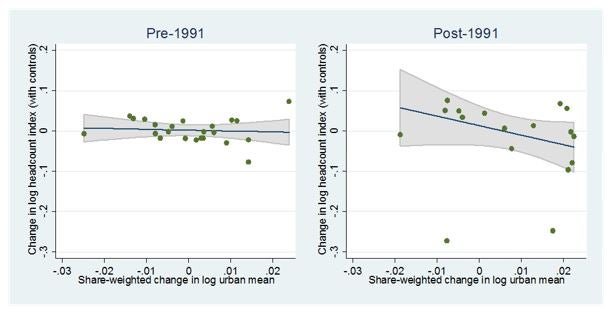
Blog #6: India, the driver of growth for Bharat
India is home to the largest number of poor people in the world, as well as the largest number of people who have recently escaped poverty. Over the next few weeks, this blog series will highlight recent research from the World Bank and its partners on what has driven poverty reduction, what still stands in the way of progress, and the road to a more prosperous India.
We hope this will spark a conversation around #WhatWillItTake to #EndPoverty in India. Read all the blogs in this series, we look forward to your comments.
How has India’s recent growth impacted poverty in the country? We look at how India’s rapid structural transformation over the past three decades —the shift from agriculture to industry and services, and from rural to urban areas – is changing the relationship between economic growth and poverty reduction.
India’s economic take-off during the 1990s and the early 2000s is now part of the country’s economic folklore. This remarkable upturn has also come with faster poverty reduction. After 1991, per capita income grew nearly two-and-a-half times faster in real terms compared to the preceding three-and-a-half decades. During this time, the fall in poverty also picked up pace. But was the faster pace of poverty reduction after 1991 simply a reflection of faster growth, or did poverty indeed become more responsive to growth? What’s more, did the changing pattern of India’s growth matter to the pace of poverty decline and, if so, in what way? We examine these issues in some detail.
Growth has become more pro-poor
First, has India’s growth become more pro-poor or not? One measure of the pro-poorness of growth is the elasticity of poverty reduction to growth – in other words, by how much did poverty decline for every 1 percent increase in per capita income or consumption. Thus, the question of whether poverty became more responsive to growth can be rephrased as whether the elasticity of poverty reduction to growth has increased or not.
It turns out the answer depends to some extent on how growth is measured. If by growth we mean changes in per capita consumption derived from household surveys, there is strong evidence that not only is the post-1991 period one of faster growth, it is also one of more pro-poor growth; the elasticity of the headcount index to growth increased from 1.5 (pre-1991) to 2.7 (post-1991). On the other hand, if growth is measured by per capita income or consumption from the national accounts, the evidence still points to a higher elasticity for the headcount index post-1991. For poverty measures that take the depth or severity of poverty into account, the evidence is mixed: higher elasticity of poverty reduction post-1991 only holds if growth is measured using the surveys, but not if it uses national accounts.
Rapid urbanisation is now driving economy-wide gains to poor people
Then, did the changing pattern of India’s growth matter to the pace of poverty decline and, if so, in what way? Our research shows that during the past two decades the rural poor gained more from urban growth than from rural growth, altering the relationship between the pattern of growth and poverty reduction that had prevailed in India so far. For instance, in the early 1950s, about 85 percent of the poor lived in rural areas and depended on the rural economy for sustenance. It is thus not surprising that before 1991 rural growth largely determined poverty reduction in the country. While urban growth did indeed reduce urban poverty, it contributed little or nothing to poverty reduction as a whole. This reflected the weak linkages between urban growth and the rural economy.
Since the early 1990s, however, this pattern has undergone a striking change. Urban growth has now emerged as a major driver of national poverty reduction. Since 1991, urban growth was responsible for about 80 percent of the total fall in poverty. This happened both directly, through urban growth having a larger impact on urban poverty, but even more importantly indirectly, through urban growth having a substantial impact on rural poverty. This indicates that the growth of cities, which have both bigger populations and higher productivity, has been good for poverty reduction as a whole in India.

Growth and poverty reduction is increasingly driven by the secondary and tertiary sectors
Next, we examined which sectors had emerged as the primary drivers of India’s growth. Before 1991, rural growth, especially in the farm sector, mattered most for poverty reduction. But in recent times, it has become more difficult to attribute poverty reduction to any specific sector. In fact, post-1991, all sectors have contributed to reducing poverty. Indeed, with the greater integration of the Indian economy, growth in one sector has begun to transmit its gains elsewhere to a greater extent than before, and the imbalance in the growth process has ceased to matter.
Because the size of the primary sector has fallen, its overall contribution to the decline in poverty has also dwindled. Whereas before 1991 the primary sector accounted for about two-fifths of the total poverty decline, after this period its contribution fell to less than 10 percent of the total - and larger – decline in poverty.
At the same time, the contribution of the other sectors to poverty reduction has risen substantially. While growth in the secondary sector accounted for about 25 percent of the fall in poverty after 1991, the tertiary sector alone contributed over 60 percent to its decline. Since 2000, India’s construction boom - which has intensively used low-skilled labour - has helped secondary sector growth to be more pro-poor.
In short, the Indian economy is changing and so is the relationship between economic growth and poverty reduction. The process of structural transformation of the economy has intensified, and with it, the traditional sources of both economic growth and poverty reduction are getting displaced. As this process continues, the country can be expected to increasingly turn to growth in its urban and non-agricultural economy to drive future poverty reduction.
This blog was originally published in the Indian Express on 13th June, 2016.
Reference:
Datt, Gaurav, Ravallion, Martin, and Murgai, Rinku, 2016, “ Growth, Urbanization and Poverty Reduction in India,” NBER Working Paper 21983.




Join the Conversation